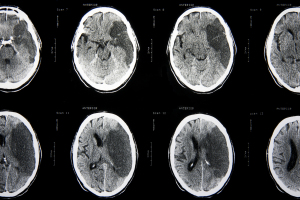The diagnosis of an ischemic stroke depends on what the clinical situation is that the physician encounters initially. It may be appropriate to do tests such as an emergency CT or MRI scan. However, the most important step initially is the stabilization of the patient.
Then it depends on many factors what the physician will do next. For instance, if the patient has an advanced age (80 years or more) there might not be any merit in further testing as further interventional therapy is rarely indicated. This age group of patients has a guarded prognosis and any heroic measure tends to only increase the mortality, so that this group of patients might be best just treated conservatively. On the other hand, younger patients would benefit greatly from plasminogen activator (TPA or tissue plasminogen activator), but this can only be given, if it is known that there is no sign and no danger of a hemorrhagic stroke.
Reference 1 shows that a triphasic perfusion CT scan (= perfusion CT; thanks to www.ajnr.org for this link) is such a tool to exclude hemorrhagic stroke safely before tPA is given intravenously.
An electroencephalogram (EEG) is done, if seizures were part of the symptoms. The physician may decide to add a toxicology screen and a blood alcohol level to rule out substance abuse.
References:
1. KH Lee et al. Arch Neurol 2000 Jul 57(7): 1000-1008.
2. S Schmulling et al. Stroke 2000 Jul 31(7): 1552-1554.
3. D Jackson et al. Clin Rehabil 2000 Oct 14(5): 538-547.
4. ML Hackett et al. Neurology 2000 Sep 12; 55 (5): 658-662.
5. K Tsutsumi et al. J Neurosurg 2000 Oct 93( 4): 550-553.
6. IS Spetzler Surg Neurol 2000 Jun 53(6): 530-540.
7. G Lot et al. Acta Neurochir (Wien) 1999; 141(6): 557-562.
8. The Merck Manual, 7th edition, by M. H. Beers et al., Whitehouse Station, N.J., 1999. Chapter 174.
9. Noble: Textbook of Primary Care Medicine, 3rd ed.,2001, Mosby Inc.
10. Ferri: Ferri’s Clinical Advisor: Instant Diagnosis and Treatment, 2004 ed., Copyright © 2004 Mosby, Inc.
11. Rakel: Conn’s Current Therapy 2004, 56th ed., Copyright 2004 Elsevier
12. Ferri: Ferri’s Clinical Advisor 2013, 1st ed. Copyright 2012 Mosby, An Imprint of Elsevier. Acute Ischemic Stroke, Hemorrhagic Stroke and Subarachnoid hemorrhage.
13. Cleveland Clinic: Current Clinical Medicine, 2nd ed. Copyright 2010 Saunders, An Imprint of Elsevier. Section 10. Neurology. Stroke treatment.
14. http://www.ncbi.nlm.nih.gov/pubmed/21911621 : Zhang Y, Tuomilehto J, Jousilahti P, Wang Y, Antikainen R, Hu G. Lifestyle factors on the risks of ischemic and hemorrhagic stroke. Arch Intern Med. 2011 Nov 14;171(20):1811-8. Epub 2011 Sep 12.
15. David Perlmutter, MD: “Grain Brain. The Surprising Truth About Wheat, Carbs, And Sugar-Your Brain’s Silent Killers.” Little, Brown and Company, New York, 2013.







